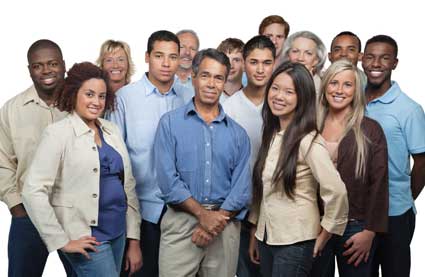
We've looked at the ways in which gender influences and affects communication efforts and leadership abilities in the workplace, and we've seen that descriptive and prescriptive stereotypes affect the ways in which individuals interact and how they think about these interactions.
A team is simply a number of people who are involved in a cooperative effort. Today, workplaces require people from vastly different backgrounds to work together in high performing teams and pressure-packed situations. Each member of the team needs to be able to relate effectively to other team members who may have different beliefs, communication styles, educational levels, cultural backgrounds, and gender identities. Because of the lack of understanding when it comes to issues of diversity, it can interfere with unity and teams often fall short of their goals.
Study after study shows that when teams seek out different perspectives, talents, and experiences, and when they actively work to incorporate them, the teams become stronger. Those teams that fail to seek out and incorporate diversity into their operation plan often are not only weaker but also decidedly less successful in achieving their goals. The difference often lies in the ability of team members to appreciate the value of their differences and take advantage of them.
Teamwork is that work-related effort by a group of people working toward a common goal. Teamwork is not sold as a technique for promoting human relations. It is viewed as good business and as more and more companies expand globally, teamwork makes it possible to increase productivity and profits. The idea of bringing the world closer together through teamwork is an effective marketing strategy. Research points to the benefits of teamwork especially when it involves people from diverse backgrounds, and a number of academic studies show that diverse teams often are more creative and innovative than their non-diverse counterparts.
One explanation for this is that globalization, the growing interdependence of people and cultures, has reshaped the way in which organizations approach business and as a result, teams need a wider range of input in order to appeal to a larger audience. It's important to point out that this shift in attitudes is more often than not profit motivated rather than purely altruistic. However, one of the major benefits of this drive to make a profit is that in changing the way in which they convey messages to consumers, organizations often end up contributing to the overarching discussion and supporting efforts to change social and cultural norms in productive and beneficial ways.
Both global and local teamwork requires team members to develop skills that will reflect and expand their own experiences and understanding of diversity consciousness. Researchers have found that the following skills are integral to the development of the types of diversity conscious thinking needed for successful teamwork.
- communication -- the process by which people transfer information
- conflict management -- the process by which conflict is dealt with in an effective and constructive manner
- empathy -- the ability to process and understand another person's point of view
- self-evaluation -- the process of checking up on oneself by continuously evaluating one's own beliefs and assumptions based on new information and input
- mindfulness -- the process of maintaining awareness of what's going on around you.
- leadership -- the act of inspiring, influencing, and empowering others to achieve a common goal
Teams that work to employ these skills tend to have a much higher rate of success in achieving their goals not only because they work well with each other, but also because the cohesiveness of the team allows them to present more comprehensive action plans to those in positions of power. This form of collective efficacy, people's shared belief that they are capable of effecting change and making a difference, can make and has made a difference in both an organization's bottom line and in its commitment to creating a more inclusive workplace.
One of the best examples of comprehensive teamwork was the 1990s LGBTQ+ campaign that Subaru launched. It not only attracted the LGBTQ+ community but it also worked to help change domestic partnership policies in the United States. It also taught the advertising team responsible for the campaign not to assume that Subaru's Japanese executive leadership would be opposed to such a groundbreaking campaign based on cultural differences. The Japanese were not opposed and already had approved the creation of workplace policies for LGBTQ+ employees in Canada.
Tech companies like Apple also are deeply invested in team building and implement policies and procedures that not only improve employees' abilities to participate in teamwork but also back it up with open floor plans that encourage employees to work together. In fact, approximately 80% of Apple's new employee training program is focused on helping new hires learn how to communicate with one another and with customers in the Apple way, which is focused on the mantra "assume positive intent."
Interest in teamwork has grown significantly in recent years since all work, whether directly or indirectly, relies on some modicum of teamwork to get it done. Organizations are becoming more team-oriented, flexible, and collaborative as they incorporate policies and plans, such as the move toward open office floor plans and away from walled off offices and cubicles designed to encourage and promote interaction. Businesses are using teams to improve marketing, customer service, and productivity as employees who may have, in the past, worked by themselves are now being organized into teams made up of diverse groups from across the organization.
While companies tout their focus on teamwork, they don't often talk about the specific details that go into building high-performance teams. Accomplished teams don't just happen because managers assign diverse members to the group and not all diverse teams end up being high performing. The key is implementing well-managed diversity and bringing team members together by giving them time to develop a sense of trust, cohesiveness, and an understanding of the norms and rules governing the team and its mission.
When aiming to create or be a part of high performing teams, it's important to understand the strategies that go into building these teams and ensuring a better chance for success. While these strategies are not focused specifically on gender sensitivity in and of itself, they are conducive to developing and maintaining an awareness of gender issues that can make team work challenging.
How do high performing teams create the conditions necessary for success? They do this by following a time-tested set of rules and moving through the set-up phase in a way that allows each team member to become comfortable with working on the team.
High performing teams tend to begin by getting to know each other before beginning work, and they use team building exercises to dig deeper for understanding since knowing who they're working with and how each individual works is essential to building trust. These teams also make sure that each member understands their purpose as well as the team's goals. Without the baseline understanding of what is to be accomplished and how team members fit into the scheme of meeting those goals, it's far more likely that the team won't perform in a way that ends with successfully meeting goals.
High performing teams operate from the perspective of respecting the ideas and feelings of other team members, and by learning how to manage conflict effectively within the team. This means that even when team members disagree, every member feels valued and respected. Often this is because high performing teams are able to avoid groupthink, the tendency to go along with a group and discourage differences of opinion.
These types of teams also view the process of team building as a continuous activity rather than a static set of rules that are set up and then ignored. Working with teams means that team members must be flexible and learn to adjust when things don't go as planned and think of themselves as a team rather than a group of individuals. This process often involves decentering (adopting multiple points of view) and recentering (constructing a common vision).
While all of these strategies combined are the key to building high performing teams, research shows that successful completion of the first step may be the most predictive of a team's potential for success. Teams that skip this first step have a much more difficult time managing workloads and relationships and have a higher chance of failure in meeting their established goals, and since there are numerous obstacles that have the potential to derail even the best of teams, it's important to have a sense of what they are in order to deal with them effectively.
Some of these obstacles can be traced to thinking and behaviors of individual team members while others originate outside the team. These obstacles can be things like social values, which stress the importance of individualism and competition that can undermine teamwork. For example, in the U.S., some workers don't share ideas because they're afraid of not getting credit for them; stereotypes, which make it difficult to see other team members as individuals; unequal distributions of power that can deny team members the ability to participate in decision making or access resources; unequal treatment or the perception of it, which undermines cohesiveness and trust and shifts the group mentality from "us" to "them"; and lack of outside support that can make a team feel cut off from the organization and make it difficult to sustain any kind of forward momentum.
As we continue to work toward understanding, developing, and sustaining a gender sensitive consciousness, the obstacles to productive teamwork will become more visible. Fortunately, we also will have developed a vast array of skills that will help prevent, minimize, and overcome these obstacles.































